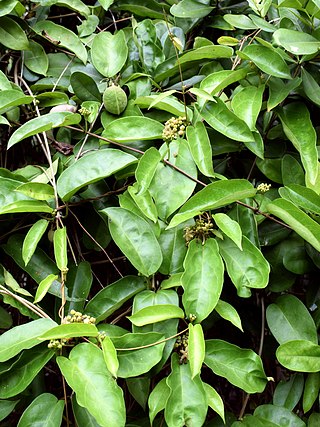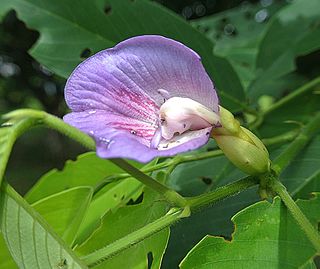
Indigofera tinctoria, also called true indigo, is a species of plant from the bean family that was one of the original sources of indigo dye.
Pongamia oil is derived from the seeds of the Millettia pinnata tree, which is native to tropical and temperate Asia. Millettia pinnata, also known as Pongamia pinnata or Pongamia glabra, is common throughout Asia and thus has many different names in different languages, many of which have come to be used in English to describe the seed oil derived from M. pinnata; Pongamia is often used as the generic name for the tree and is derived from the genus the tree was originally placed in. Other names for this oil include honge oil, kanuga oil, karanja oil, and pungai oil.

Millettia pinnata is a species of tree in the pea family, Fabaceae, native to eastern and tropical Asia, Australia, and Pacific islands. It is often known by the synonym Pongamia pinnata. Its common names include Indian beech and Pongame oiltree.

Ziziphus nummularia, commonly known as wild jujube or jhahrberi in Hindi, is a species of Ziziphus native to the Thar Desert of western India and southeastern Pakistan, south Iran, Afghanistan, Lebanon and Zimbabwe. Ziziphus nummularia is a shrub up to 6 metres (20 ft) or more high, branching to form a thicket. The leaves are rounded like those of Ziziphus jujuba but differ from those in having a pubescence on the adaxial surface. The plant is commonly found in arid areas, hills, plains, and agricultural fields.

Millettia laurentii is a legume tree from Africa and native to the Republic of Congo, the Democratic Republic of Congo, Cameroon, Gabon and Equatorial Guinea. The species is listed as "endangered" in the IUCN Red List, principally due to destruction of its habitat and over-exploitation for timber. Wenge, a dark coloured wood, is the product of Millettia laurentii. Other names sometimes used for wenge include faux ebony, dikela, mibotu, bokonge, and awong. The wood's distinctive colour is standardised as a "wenge" colour in many systems.

Millettia is a genus of flowering plant in the family Fabaceae. It consists of about 150 species, which are distributed in the tropical and subtropical regions of the world. The genus was formerly known by the name Pongamia, but that name was rejected in favor of the name Millettia, and many species have been reclassified. Due to recent interest in biofuels, Pongamia is often the generic name used when referring to Millettia pinnata, a tree being explored for producing biodiesel.

Eriodictyol is a bitter-masking flavanone, a flavonoid extracted from yerba santa, a plant native to North America. Eriodictyol is one of the four flavanones identified in this plant as having taste-modifying properties, the other three being homoeriodictyol, its sodium salt, and sterubin.

Tephrosin is rotenoid. It is a natural fish poison found in the leaves and seeds of Tephrosia purpurea and T. vogelii.

Amorpha fruticosa is a species of flowering plant in the legume family Fabaceae, known by several common names, including desert false indigo, false indigo-bush, and bastard indigobush. It is native to North America.

Prenylated flavonoids or prenylflavonoids are a sub-class of flavonoids. They are widely distributed throughout the plant kingdom. Some are known to have phytoestrogenic or antioxidant properties. They are given in the list of adaptogens in herbalism. Chemically they have a prenyl group attached to their flavonoid backbone. It is usually assumed that the addition of hydrophobic prenyl groups facilitate attachment to cell membranes. Prenylation may increase the potential activity of its original flavonoid.

Alpinumisoflavone is a pyranoisoflavone, a type of isoflavone. It can be found in the bark of Rinorea welwitschii. It can also be found in the molluscicide plant Millettia thonningii and is thought to be an antischistosomal agent since it has been shown to kill the snails which transmit the schistosomiasis and also the larvae of the parasite itself.

Millettia pachycarpa is a perennial climbing shrub belonging to the genus Millettia. It is one of the most well known among ~150 species of Millettia, as it is widely used in traditional practices, such as for poisoning fish, agricultural pesticide, blood tonic, and treatments of cancer and infertility. The bark fiber is used for making strong ropes.

Barbigerone is one of a few pyranoisoflavones among several groups of isoflavones. It was first isolated from the seed of a leguminous plant Tephrosia barbigera; hence the name "barbigerone". Members of the genus Millettia are now known to be rich in barbigerone, including M. dielsiena, M. ferruginea, M. usaramensis, and M. pachycarpa. It has also been isolated from the medicinal plant Sarcolobus globosus. Barbigerone from S. globosus is validated to have significant antioxidant property. Barbigerone exhibits profound antiplasmodial activity against the malarial parasite Plasmodium falciparum. It is also demonstrated that it has anti-cancer potential as it causes apoptosis of murine lung-cancer cells.

Sarcolobus globosus is a twining shrub native to tropical regions of Asia including India, China, Thailand, Malaysia, Myanmar-Burma, the Philippines and Indonesia.

Millettia peguensis, the Moulmein rosewood, is a legume tree species in the genus Millettia. It is native to Lower Burma and Siam. This is a relatively rare tree as compared to pongam that is very similar looking, but more common in India. Pongam has white flowers while the Milletia flowers are bright pink. Pongam has more elongated tip to leaves, while those of M. peguensis are more oval. The plant is a food source for the Jamides bochus caterpillar.

Rotenoids are naturally occurring substances containing a cis-fused tetrahydrochromeno[3,4-b]chromene nucleus. Many have insecticidal activity, such as the prototypical member of the family, rotenone. Rotenoids are related to the isoflavones.

Derris trifoliata is a plant species in the genus Derris of the family Fabaceae. It is known as "Karanjvel" in Marathi - local language of Maharashtra, India.

Clitoria fairchildiana, the sombreiro, is a flowering plant species in the genus Clitoria found in Campina Grande, Brazil.

Senna siamea, also known as Siamese cassia, kassod tree, cassod tree and cassia tree, is a legume in the subfamily Caesalpinioideae. It is native to South and Southeast Asia, although its exact origin is unknown.

Tahliah Debrett Barnett, known professionally as FKA Twigs, is an English singer, songwriter, and dancer. Born and raised in Cheltenham, she became a backup dancer for numerous famous musicians after moving to London at the age of 17, and made her own musical debut with EP1 (2012).

















